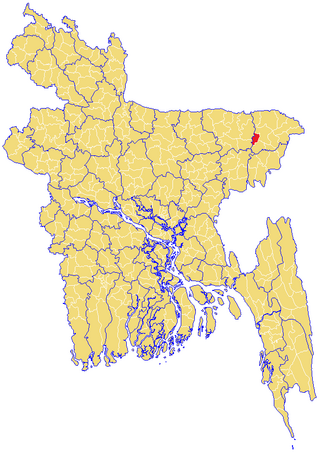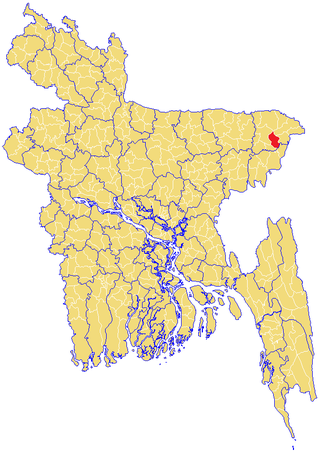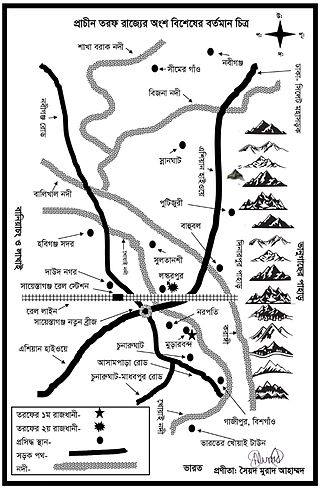Related Research Articles

Habiganj, formerly known as Habibganj, is a district in north-eastern Bangladesh, located in the Sylhet Division. It was established as a district in 1984 as a successor to its subdivision status since 1867. It is named after its headquarters, the town of Habiganj.

The Jaintia Kingdom was a matrilineal kingdom in present-day some parts of Bangladesh's Sylhet Division, India's Meghalaya state and Nagaon, Morigoan district of Assam. It was partitioned into three in 630 AD by Raja Guhak for his three sons, into the Jaintia Kingdom, Gour Kingdom and Laur Kingdom. It was annexed by the British East India Company in 1835. All the Khasi (Pnar) Rajahs of the Jaintiapur Kingdom are from the Syiem Sutnga clan, a Pnar clan of the Khasi tribe which claims descent from Ka Li Dohkha, a divine nymph.

Jalāl Mujarrad Kunyāʾī, popularly known as Shah Jalal, was a celebrated Sufi figure of Bengal. His name is often associated with the Conquest of Sylhet and the Spread of Islam into the region, part of a long history of interactions between the Middle East, Central Asia, and South Asia. Various complexes and religious places have been named after him, including the largest airport in Bangladesh, Hazrat Shahjalal International Airport.

Bishwanath is an upazila of Sylhet District in the Division of Sylhet, Bangladesh.

Golapganj Upazila, previously known as Gulabganj, is an upazila of Sylhet District in the Division of Sylhet, Bangladesh.
The Conquest of Sylhet predominantly refers to an Islamic conquest of Srihatta led by Sikandar Khan Ghazi, the military general of Sultan Shamsuddin Firoz Shah of the Lakhnauti Sultanate, against the Hindu king Gour Govinda. The conquest was aided by a Muslim saint known as Shah Jalal, who later ordered his disciples to scatter throughout eastern Bengal and propagate the religion of Islam. The Conquest of Sylhet may also include other minor incidents taking place after Govinda's defeat, such as the capture of nearby Taraf.

The Greater Sylhet region predominantly included the Sylhet Division in Bangladesh, and Karimganj district in Assam, India. The history of the Sylhet region begins with the existence of expanded commercial centres in the area that is now Sylhet City. Historically known as Srihatta and Shilhatta, it was ruled by the Buddhist and Hindu kingdoms of Harikela and Kamarupa before passing to the control of the Sena and Deva dynasties in the early medieval period. After the fall of these two Hindu principalities, the region became home to many more independent petty kingdoms such as Jaintia, Gour, Laur, and later Taraf, Pratapgarh, Jagannathpur, Chandrapur and Ita. After the Conquest of Sylhet in the 14th century, the region was absorbed into Shamsuddin Firoz Shah's independent principality based in Lakhnauti, Western Bengal. It was then successively ruled by the Muslim sultanates of Delhi and the Bengal Sultanate before collapsing into Muslim petty kingdoms, mostly ruled by Afghan chieftains, after the fall of the Karrani dynasty in 1576. Described as Bengal's Wild East, the Mughals struggled in defeating the chieftains of Sylhet. After the defeat of Khwaja Usman, their most formidable opponent, the area finally came under Mughal rule in 1612. Sylhet emerged as the Mughals' most significant imperial outpost in the east and its importance remained as such throughout the seventeenth century. After the Mughals, the British Empire ruled the region for over 180 years until the independence of Pakistan and India. There was a complete list of the different amils who governed Sylhet which was recorded in the office of the Qanungoh of Sylhet. However, most complete copies have been lost or destroyed. Dates from letters and seal traces show evidence that the amils were constantly changed. In 1947, when a referendum was held, Sylhet decided to join the Pakistani province of East Bengal. However, when the Radcliffe Line was drawn up, Karimganj district of Barak Valley was given to India by the commission after being pleaded by Abdul Matlib Mazumdar's delegation. Throughout the History of Sylhet, raids and invasions were also common from neighbouring kingdoms as well as tribes such as the Khasis and Kukis.
Sikandar Khān Ghāzī was the first wazir of Srihat under the Lakhnauti Kingdom ruled by Shamsuddin Firuz Shah. Prior to this, Khan was one of the commanders of the Battles of Gour during the Conquest of Sylhet in 1303. Early Persian manuscripts and inscriptions relating to Shah Jalal name Sikandar Khan Ghazi as well, highlighting his role as a commander in the battles.
Govinda Fenchu, better known by his regnal title Gour Gobind and also known by the sobriquet Shomudro Tonoy, was the 21st and final king of medieval Sylhet's Gour Kingdom. He is described as a very conservative Hindu ruler whose reign started in 1260.
The Kingdom of Brahmachal, also known as Badapanchala, was one of the many petty kingdoms of the Sylhet region. It was established by Brahmajit by gradually off-shooting from the Gour Kingdom in 1170 AD due to familial tensions. It would reunite during the reign of Govardhan of Gour for a few years before being annexed to the Twipra Kingdom. Govardhan's successor, Gour Govinda, would again reunite Brahmachal with Gour in 1260.
Gangadhwaj Govardhan was the 20th king of medieval Sylhet's Gour Kingdom.
Madan Rai was the penultimate chief minister of medieval Sylhet's Gour Kingdom. He was described to have been very sharp and "shrewd".
Jaidev Rai was the Governor of Brahmachal under the Twipra Kingdom.
Amar Singh, was the military general for Raja Upananda of Brahmachal, and later its king.
Shaykh Gharib Khan Nistani Afghani, popularly known as Shāh Gabru, was a 14th-century Sufi Muslim figure from the Sylhet region. Gabru's name is associated with the propagation of Islam in Osmani Nagar. In 1303, he joined Shah Jalal in the Conquest of Sylhet.

The Kingdom of Gour was one of the greater of the many petty kingdoms of the medieval Sylhet region. According to legend, it was founded by Gurak, off-shooting from Kamarupa's Jaintia Kingdom in 630. Much of its early history is considered legendary or mythological up until Navagirvana who is mentioned in the Bhatera copper-plate inscriptions. The Kings of Gour are described as patrons of Hindu revivalism in what was previously a predominantly Buddhist and animist populated land.

Taraf, previously known as Tungachal, was a feudal territory of the Sylhet region in Bengal and was under many petty kingdoms in different periods of time. It was part of what is present-day Habiganj District in Bangladesh.
Ādam Khākī, also known as Khaki Pir, was a 14th-century Sufi Muslim figure in the Sylhet region. In 1303, he took part in the final battle of the Conquest of Sylhet led by Shah Jalal. His shrine has become a popular tourist site.

The Shah Jalal Dargah is the shrine and burial place of the 14th century Muslim saint Shah Jalal, located in Sylhet, Bangladesh. The site, known as a dargah, was originally constructed c. 1500, though many additions and alterations were made to its structures over the following centuries. It became a religious centre in the region, respected across multiple ruling administrations and greatly venerated among Bengalis, with local folklore and legends developing around it. The extensive surrounding compound serves several functions and includes four mosques, a religious school and a public cemetery among others. The Dargah is presently the largest and most visited religious site in Bangladesh.
References
- ↑ Fazlur Rahman (1991). Sileter Mati, Sileter Manush. MA Sattar. p. 43.
- ↑ Bhattacharya, Shubhrendu Shekhar (21 May 2018). "যেন এক অমরাবতী!". Jugantor (in Bengali).
- 1 2 3 Nath, Rajmohan (1948). The back-ground of Assamese culture. A. K. Nath. pp. 114 & 120.
- ↑ Dr Yahya Mannan; Abdul Halim Khan (20 Jul 2019). "আবদুল হালিম খাঁ রচিত শাহজালালের জায়নামায উপন্যাসের শৈল্পিক নির্মিতি". Sohojat (in Bengali).
- ↑ Ahmed, Jalal (1969). Śoṇita dhārā: etihāsika nāṭeka (in Bengali). Sāhitya Kuṭir.
- ↑ "ধার্মিক হিন্দু রাজা গৌড় গোবিন্দ সিলেটে তার ইতিহাস" (in Bengali). Ajker Diganta. 25 Mar 2019.
- ↑ Sengupta, Nitish (2011). Land of Two Rivers: A History of Bengal from the Mahabharata to Mujib. Penguin Books.
- ↑ Dewan Nurul Anwar Husayn Chowdhury. Hazrat Shah Jalal (R).
- ↑ Chowdhury, Aftab (27 Sep 2019). "সিলেটে পর্যটন শিল্প বিকাশে সমস্যা ও সম্ভাবনা". Alokito Bangladesh (in Bengali).
- ↑ Dash, Purnendukanti. Amar Kal Amar Bhuban (in Bengali). Parul Prakashani Private Limited.
- ↑ Kamal, Syed Mustafa (7 Feb 2015). "ইতিহাসের নামে কিচ্ছা-কিংবদন্তিও ব্রেইন মেইড স্টোরি". The Daily Sangram (in Bengali).
- ↑ Bipin Chandra Pal (1932). Memories Of My Life And Times. pp. 33 & 149.
- ↑ Sengupta, Padmini Sathianadhan (1970). Pandita Ramabai Saraswati: her life and work. Asia Pub. House. p. 71.
- ↑ Bangladesh District Gazetteers: Sylhet. Bangladesh Government Press. 1975. pp. 184 & 409.